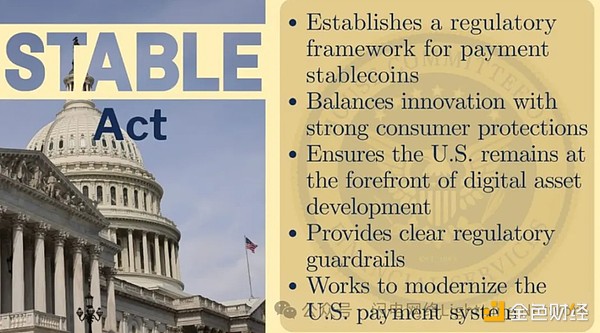Author: shaaa, Bankless; Translator: Lightning Network Chinese Community
In 2025, stablecoins are gradually becoming a key player in the evolution of global finance.
The United States has finally begun to take concrete steps to clearly define the future of the digital dollar through two aptly named bills.
Two important pieces of legislation, the "GENIUS Act" and the "STABLE Act", are currently being considered by Congress, promising to establish a clear and comprehensive legal framework.

![]()
![]()
Shaaa, a contributor to the cryptocurrency news media bankless.com, recently reported the latest information on the two bills:
【Introduction to Proposed Legislation】
First of all, what are these two bills? What progress has been made so far?
The GENIUS Act (Guiding and Establishing a National Innovation for Stablecoins in the United States), introduced by bipartisan senators in February 2025, focuses on federal licenses for stablecoin issuers.
Main contents include:
- Federal licensing for stablecoin issuers
- Stablecoins must be 100% backed by US dollars or US Treasury bonds
- Provisions for regular audits, anti-money laundering compliance (AML) and public reserve notifications
The bill has received strong bipartisan support from the Senate Banking Committee, passing 18 to 6.
On the other hand, the STABLE Act (Stablecoin Transparency and Accountability for Better Ledger Economy) has been passed by the House Financial Services Committee by 32 to 17 votes.
Key points include:
- Protecting consumer rights by clarifying redemption rights
- Emphasizing reserve transparency
- Strengthening regulatory mechanisms
- Applicable to domestic and foreign stablecoin issuers operating in the United States
【Main topics】
As the bill moves forward, several key topics are being discussed.
One is the regulation of algorithmic stablecoins-Remember Terra Luna? Congress is cautious and hopes to obtain more research before deciding how to regulate uncollateralized stablecoins.
- The GENIUS Act directly prohibits algorithmic stablecoins.
- The STABLE Act proposes a two-year suspension policy for whitelisted algorithmic stablecoins.
Second, restrictions on foreign stablecoin issuers.
More and more voices support restricting foreign stablecoins from operating in the United States unless they complete registration and fully comply with U.S. regulations. This will profoundly affect the competitive landscape of the global stablecoin market.
Finally, policymakers are increasingly aware that if effectively regulated, stablecoins will help significantly promote the global adoption of the U.S. dollar, which highlights the strategic importance of stablecoin regulation.
[Legislative Path]
After understanding the issues and the progress of the bill, what will happen next?
In the United States, a bill must become law after:
- Passed by one house (House of Representatives or Senate)
- Passed by the other house (may be amended)
- Coordinated versions of the two houses at different times
- Signed by the President
Currently, the STABLE Act has passed the House Financial Services Committee and is awaiting a vote by the full House.
Similarly, the GENIUS Act has passed the Senate Banking Committee and is awaiting a vote by the full Senate.
Because the GENIUS Act was proposed first and has completed the Senate committee stage, its legislative progress is slightly ahead of the STABLE Act.
The timeline for the future is as follows:
- May 2025: Senate Majority Leader John Thune privately informs Republican senators that the GENIUS Act will be voted on before May 31.
- Summer 2025: The STABLE Act is expected to be voted on by the House and Senate.
- Late summer to early fall 2025: Congress will reconcile the differences between the two bills and form a final compromise version.
- Fall 2025 (probably September to October): If all goes well, the bill will be passed by both houses and submitted to the President for signature.
- End of 2025: Comprehensive stablecoin regulation is expected to be launched by the end of the year.
【Potential obstacles】
As is common in American politics, there may be obstacles in the process and the above deadlines may be missed.
Possible reasons include:
- As the election cycle approaches, Congress’ attention and priorities shift
- Crypto industry parties continue to lobby, causing delays on details
- The debate on whether to adopt independent stablecoin legislation or incorporate it into broader market structure legislation has increased uncertainty
- Concerns among some Democrats and banks about potential deposit outflows may trigger further negotiations
【More macro perspective】
The United States is steadily advancing the establishment of a clear legal framework for stablecoins, which is highly optimistic. Considering Gary Gensler’s ongoing litigation against us, we’ve come a long way!
If both GENIUS and STABLE are approved, stablecoins will become an integral part of the U.S. financial system, subject to licensing, consumer protection, and enhanced regulation.
This is more than an opportunity:
If policy is right, stablecoins will solidify the dollar’s dominance in the digital age.
But if it’s wrong, other countries with clearer regulatory environments may seize the lead in the development of digital finance.
Bankless Nation, there is no doubt that these stablecoin bills will become the infrastructure of the crypto future.
We will continue to follow the follow-up developments of both cases and keep you updated.
 Kikyo
Kikyo
 Kikyo
Kikyo Hui Xin
Hui Xin Brian
Brian Joy
Joy Alex
Alex Kikyo
Kikyo Hui Xin
Hui Xin Alex
Alex Brian
Brian Hui Xin
Hui Xin